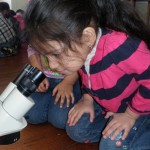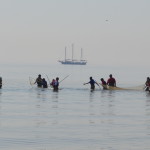March 2012 – 8th Grade Scientists Test Water and Soil at Mianus River
Every Stamford 8th grader is headed to the Mianus River during March and April, but it is more than just a walk in the park. These middle school students are engaged in a science enrichment program with SoundWaters to conduct numerous experiments, using scientific instruments to test and compare water and soil at various points along the river.
Every Stamford 8th grader is headed to the Mianus River during March and April, but it is more than just a walk in the park. These middle school students are engaged in a science enrichment program with SoundWaters to conduct numerous experiments, using scientific instruments to test and compare water and soil at various points along the river.
The field studies are one of five inquiry-based activities that comprise a semester-long, 19-hour meaningful watershed education experience. The lessons are aligned to support and amplify CT state science standards and offer a vital outdoor antidote to students’ indoor screen time. The curriculum is full of engaging science, technology, engineering and math, or STEM, projects, demonstrating to students that learning science can be fun.
The program will culminate at the SoundWaters Coastal Center in late spring when students will compare their freshwater findings from the river with brackish water in Long Island Sound. The program began earlier this year with interactive, hands-on activities in the classroom focusing on the Long Island Sound Watershed and practice using scientific instruments. This is the third year that SoundWaters has offered the program to Stamford students, which is funded by the National Oceanic and Atmospheric Administration (NOAA).
While at the river, students conduct experiments at four different stations: They walk down a slope from the wooded area, across a walking path and toward the river, digging into the soil and taking core samples along the way; the are measuring changes in ph levels that determine how different soils filter out acidic pollutants. They throw buoys into two spots in the river and use digital meters to calculate river flow rates to determine which factors contribute to any differences they observe. They lower bottles in standing and flowing water to trap water samples to compare water quality in surface and bottom water. And they use scientific equipment to measure turbidity (cloudiness), temperature and oxygen levels to determine how the flow of water affects change in these parameters.
This experience builds upon lessons learned in class but is unlike any opportunity available in the classroom. By securing the grant from NOAA, SoundWaters is able to to provide the program free of charge for the students and the schools. SoundWaters provides extensive equipment so that every is engaged in testing, sampling, measuring and perhaps, most important, observing their natural environment in ways they never imagined.
Regards,
Leigh Shemitz, Ph.D.
Executive Director
SoundWaters




